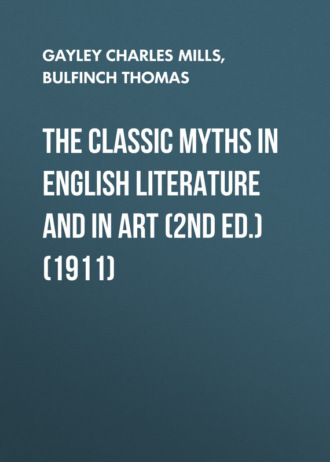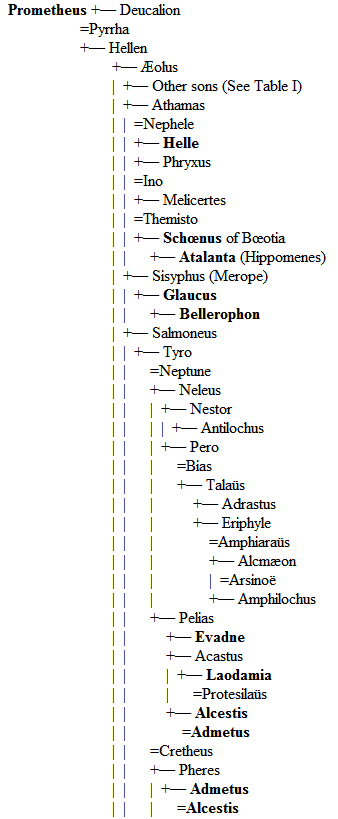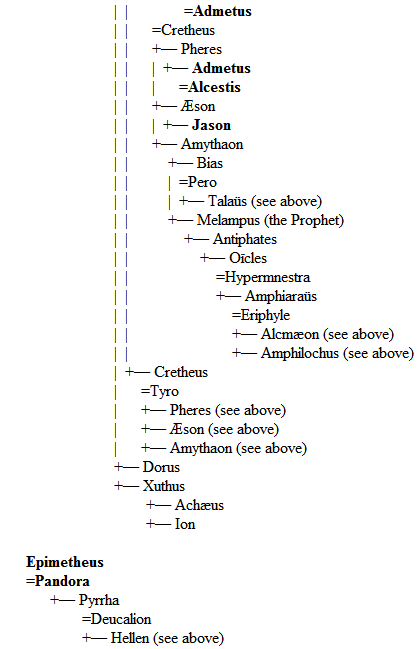 полная версия
полная версияThe Classic Myths in English Literature and in Art (2nd ed.) (1911)
Illustrative. The realistic Idyl XV of Theocritus contains a typical Psalm of Adonis, sung at Alexandria, for his resurrection. Shakespeare's Venus and Adonis; Taming of the Shrew, Induction ii; 1 Henry VI, I, vi. In Milton, Comus, 998:
Beds of hyacinth and roses,Where young Adonis oft reposes,Waxing well of his deep wound,In slumber soft, and on the groundSadly sits th' Assyrian queen.Drummond, The Statue of Adonis; Pope, Summer, 61; Winter, 24; Miscel. 7, 10; Moral Essays, 3, 73; Dunciad, 5, 202. See C. S. Calverley, Death of Adonis (Theocritus); L. Morris, Adonis (Epic of Hades).
In Art. Fig. 74, in text, from a Roman sarcophagus. The Dying Adonis, (sculpture), Michelangelo; the Adonis of Thorwaldsen in the Glyptothek, Munich.
101-102. Textual. Psyche does not eat anything in Hades, because, by accepting the hospitality of Proserpina, she would become an inmate of her household. The scene with the lamp and knife probably indicates the infringement of some ancient matrimonial custom. Erebus: the land of darkness, Hades. For Zephyr, Acheron, Cerberus, Charon, etc., see Index.
Interpretative. The fable of Cupid and Psyche is usually regarded as allegorical. The Greek name for butterfly is Psyche, and the same word means the soul. There is no illustration of the immortality of the soul so striking and beautiful as that of the butterfly, bursting on brilliant wings from the tomb in which it has lain, after a dull, groveling, caterpillar existence, to flutter in the blaze of day and feed on the most fragrant and delicate productions of the spring. Psyche, then, is the human soul, which is purified by sufferings and misfortunes, and is thus prepared for the enjoyment of true and pure happiness. It is probable that the story allegorizes a philosophical conception concerning three stages of the soul's life: first, a former existence of bliss; second, an earthly existence of trial; third, a heavenly future of fruition. Cox, by his usual method, finds here a myth of the search for the Sun (Eros) by the Dawn (Psyche). Many of the incidents of the story will be found in modern fairy tales and romances, such as Beauty and the Beast, Grimm's Twelve Brothers; the Gaelic stories: The Three Daughters of King O'Hara; Fair, Brown, and Trembling; The Daughter of the Skies; and the Norse tale – East of the Sun and West of the Moon. See Cox 1, 403-411.
Illustrative. Thomas Moore, Cupid and Psyche; Mrs. Browning, Psyche, Paraphrase on Apuleius; L. Morris, in The Epic of Hades; Frederick Tennyson, Psyche; Robert Bridges, Eros and Psyche. Most important is W. H. Pater's Marius the Epicurean, which contains the story as given by Apuleius.
In Art. Psyche is represented as a maiden with the wings of a butterfly, in the different situations described in the allegory. The Græco-Roman sculpture of Cupid and Psyche, in the Capitol at Rome, is of surpassing beauty; so also is Canova's Cupid and Psyche.
Paintings. Raphael's frescoes in the Farnesina Villa, twelve in number, illustrating the story; François Gérard's Cupid and Psyche; Paul Thumann's nine illustrations of the story (see Figs. 75, 76, in text); R. Beyschlag's Psyche with the Urn, Psyche Grieving, and Psyche and Pan; W. Kray's Psyche and Zephyr; Psyche: by A. de Curzon; by G. F. Watts, a series of three illustrations by H. Bates. The Charon and Psyche of E. Neide is a sentimental, simpering conception. A. Zick also has a Psyche.
103. According to another tradition, Atalanta's love was Milanion. The nuptial vow was ratified by Hera (Juno). This, the Bœotian, Atalanta is sometimes identified with the Arcadian Atalanta of the Calydonian Hunt. (See 168 and Table D). It is better to discriminate between them. The genealogy of this Atalanta will be seen in Tables G and I.
Illustrative. W. Morris, Atalanta's Race (Earthly Paradise); Moore, Rhymes on the Road, on Alpine Scenery, – an allusion to Hippomenes.
In Art. Painting by E. J. Poynter, Atalanta's Race (Fig. 78, in text); and Guido Reni's brilliant picture of the same subject.
104. Textual and Illustrative. The story of Hero and Leander is the subject of a romantic poem by Musæus, a grammarian of Alexandria, who lived in the fifth century A.D. This author, in distinction from the mythical poet of the same name, is styled the Pseudo-Musæus. The epyllion has been translated by Sir Robert Stapylton, Sir Edwin Arnold, and others. The feat of swimming the Hellespont was performed by Lord Byron. The distance in the narrowest part is not more than a mile, but there is a constant dangerous current setting out from the Sea of Marmora into the Archipelago. For an allusion to the story see Byron, Bride of Abydos, Canto II. For Byron's statement concerning the breadth of the water see footnote to "Stanzas written after swimming from Sestos to Abydos."
Poems. Hero and Leander: by Leigh Hunt, by Tom Hood, by Moore; sonnet by D. G. Rossetti, Hero's Lamp (House of Life); a poem not in later editions of Tennyson, Hero to Leander, 1830; Chapman's continuation of Marlowe's Hero and Leander.
Paintings. G. von Bodenhausen; F. Keller (Fig. 79, in text).
105. Interpretative. Another illustration of the vivifying influence of love. Preller deems Pygmalion's story nearly akin to the Adonis myth. He regards the festival of Venus, during which the statue of Galatea (or passive love) receives life, as the usual Adonis-festival.
Table G. The Connections of Atalanta the Bœotian


Illustrative. Thomson, Castle of Indolence, 2, 12; R. Buchanan, Pygmalion the Sculptor; Morris, and Lang, as in text; Pygmalion: by T. L. Beddoes, by W. C. Bennett. The seventeenth-century satirist, Marston, wrote a Pygmalion, of no great worth. Frederick Tennyson, Pygmalion (in Daphne and other Poems); Arthur Henry Hallam, Lines spoken in the Character of Pygmalion; Thomas Woolner, Pygmalion.
In Art. The Pygmalion series of four scenes, by E. Burne-Jones.
106. Textual. Semiramis: wife of King Ninus and the queen of Assyria. Famous for her administrative and military ability. A mythical character with features of historic probability.
Illustrative. Chaucer, Thisbe, the Martyr of Babylon (Legende of Good Women). Allusions in Surrey, Of the Death of Sir Thomas Wyatt; Shakespeare, Midsummer Night's Dream, III, ii; V, i; Merchant of Venice, V, i. Moore, in the Sylph's Ball, draws a comparison between Thisbe's wall and the gauze of Davy's safety lamp. Mickle's translation of the Lusiad (Island of Love).
In Art. Burne-Jones' three paintings, Cupid, Pyramus, and Thisbe (Fig. 80, in text); E. J. Paupion's painting, Thisbe.
107. Textual. Lesbos and Chios: islands in the Ægean. For Sappho see 298 (3).
Illustrative. The second lyric of Sappho, beginning "Like to the gods he seems to me, The man that sits reclined by thee," has been translated by Phillips, by Fawkes, and by recent poets. The reference is probably to Phaon. Allusions in Pope, Moral Essays, 3, 121; 2, 24; Prologue to Satires, 309, 101; Byron's Isles of Greece, already referred to. Compare the translation in Catullus, LI.
Poems on Sappho or on Phaon: Charles Kingsley, Sappho; Buchanan, Sappho on the Leucadian Rock; Landor, – Sappho, Alcæus, Anacreon, and Phaon; Frederick Tennyson, Kleïs or the Return (in the Isles of Greece). See also Lyly's amusing prose drama, Sappho and Phao.
109. Textual. Mount Cyllene: between Arcadia and Achæa. Pierian Mountains: in Macedonia, directly north of Thessaly; the birthplace of the Muses. Pylos: an ancient city of Elis.
Interpretative. On the supposition that the herds of Apollo are the bright rays of the sun, a plausible physical explanation of the relations of Mercury (Hermes) to Apollo is the following from Max Müller: "Hermes is the god of the twilight, who betrays his equivocal nature by stealing, though only in fun, the herds of Apollo, but restoring them without the violent combat that (in the analogous Indian story) is waged for the herds between Indra, the bright god, and Vala, the robber. In India the dawn brings the light; in Greece the twilight itself is supposed to have stolen it, or to hold back the light, and Hermes, the twilight, surrenders the booty when challenged by the sun-god Apollo" (Lect. on Lang., 2 Ser., 521-522). Hermes is connected by Professor Müller with the Vedic god Sarameya, son of the twilight. Mercury, or Hermes, as morning or as evening twilight, loves the Dew, is herald of the gods, is spy of the night, is sender of sleep and dreams, is accompanied by the cock, herald of dawn, is the guide of the departed on their last journey. To the conception of twilight, Cox adds that of motion, and explains Hermes as the air in motion that springs up with the dawn, gains rapidly in force, sweeps before it the clouds (here the cattle of Apollo), makes soft music through the trees (lyre), etc. Other theorists make Hermes the Divine Activity, the god of the ether, of clouds, of storm, etc. Though the explanations of Professor Müller and the Rev. Sir G. W. Cox are more satisfactory here than usual, Roscher's the swift wind is scientifically preferable.
Illustrative. See Shelley, Homeric Hymn to Mercury, on which the text of this section is based, and passages in Prometheus Unbound; Keats, Ode to Maia.
In Art. The intent of the disguise in Fig. 81 (text) is to deceive Demeter with a sham sacrifice.
110-112. Textual. See Table E, for Bacchus, Pentheus, etc. Nysa "has been identified as a mountain in Thrace, in Bœotia, in Arabia, India, Libya; and Naxos, as a town in Caria or the Caucasus, and as an island in the Nile." Thebes: the capital of Bœotia. Mæonia: Lydia, in Asia Minor. Dia: Naxos, the largest of the Cyclades Islands in the Ægean. Mount Cithæron: in Bœotia. The Thyrsus was a wand, wreathed with ivy and surmounted by a pine cone, carried by Bacchus and his votaries. Mænads and Bacchantes were female followers of Bacchus. Bacchanal is a general term for his devotees.
Interpretative. "Bacchus (Dionysus) is regarded by many as the spiritual form of the new vernal life, the sap and pulse of vegetation and of the new-born year, especially as manifest in the vine and juice of the grape." – Lang, Myth, Ritual, etc., 2, 221 (from Preller 1, 554). The Hyades (rain-stars), that nurtured the deity, perhaps symbolize the rains that nourish sprouting vegetation. He became identified very soon with the spirituous effects of the vine. His sufferings may typify the "ruin of the summer year at the hands of storm and winter," or, perhaps, the agony of the bleeding grapes in the wine press. The orgies would, according to this theory, be a survival of the ungoverned actions of savages when celebrating a festival in honor of the deity of plenty, of harvest home, and of intoxication. But in cultivated Greece, Dionysus, in spite of the surviving orgiastic ceremonies, is a poetic incarnation of blithe, changeable, spirited youth. See Lang, Myth, Ritual, etc., 2, 221-241. That Rhea taught him would account for the Oriental nature of his rites; for Rhea is an Eastern deity by origin. The opposition of Pentheus would indicate the reluctance with which the Greeks adopted his doctrine and ceremonial. The Dionysiac worship came from Thrace, a barbarous clime; – but wandering, like the springtide, over the earth, Bacchus conquered each nation in turn. It is probable that the Dionysus-Iacchus cult was one of evangelical enthusiasm and individual cleansing from sin, of ideals in this life and of personal immortality in the next. By introducing it into Greece, Pisistratus reformed the exclusive ritual of the Eleusinian Mysteries.
Of the Festivals of Dionysus, the more important in Attica were the Lesser Dionysia, in December; the Lenæa, in January; the Anthesteria, or spring festival, in February; and the Great Dionysia, in March. These all, in greater or less degree, witnessed of the culture and the glories of the vine, and of the reawakening of the spirits of vegetation. They were celebrated, as the case might be, with a sacrifice of a victim in reminiscence of the blood by which the spirits of the departed were supposed to be nourished, with processions of women, profusion of flowers, orgiastic songs and dances, or dramatic representations.
Illustrative. Bacchus: Milton, Comus, 46. Pentheus: Landor, The Last Fruit of an Old Tree; H. H. Milman, The Bacchanals of Euripides; Calverley's and Lang's translations of Theocritus, Idyl XXVI; Thomas Love Peacock, Rhododaphne: The Vengeance of Bacchus; B. W. Procter, Bacchanalian Song. Naxos: Milton, Paradise Lost, 4, 275.
In Art. Figs. 31, 82-87, 143, in text.
113. Textual. Hesperides, see Index. River Pactolus: in Lydia. Midas: the son of one Gordius, who from a farmer had become king of Phrygia, because he happened to fulfill a prophecy by entering the public square of some city just as the people were casting about for a king. He tied his wagon in the temple of the prophetic deity with the celebrated Gordian Knot, which none but the future lord of Asia might undo. Alexander the Great undid the knot with his sword.
Interpretative. An ingenious, but not highly probable, theory explains the golden touch of Midas as the rising sun that gilds all things, and his bathing in Pactolus as the quenching of the sun's splendor in the western ocean. Midas is fabled to have been the son of the "great mother," Cybele, whose worship in Phrygia was closely related to that of Bacchus or Dionysus. The Sileni were there regarded as tutelary genii of the rivers and springs, promoting fertility of the soil. Marsyas, an inspired musician in the service of Cybele, was naturally associated in fable with Midas. The ass being the favorite animal of Silenus, the ass's ears of Midas merely symbolize his fondness for and devotion to such habits as were attributed to the Sileni. The ass, by the way, was reverenced in Phrygia; the acquisition of ass's ears may therefore have been originally a glory, not a disgrace.
Illustrative. John Lyly, Play of Mydas, especially the song, "Sing to Apollo, god of day"; Shakespeare, Merchant of Venice, III, ii (casket scene); Pope, Dunciad, 3, 342; Prologue to Satires, 82; Swift, The Fable of Midas; J. G. Saxe, The Choice of King Midas (a travesty). Gordian Knot: Henry V, I, i; Cymbeline, II, ii; Milton, Paradise Lost, 4, 348; Vacation, 90. Pactolus: Pope, Spring, 61; allusions also to the sisters of Phaëthon. Silenus, by W. S. Landor.
114-117. Textual. Mount Eryx, the vale of Enna, and Cyane are in Sicily. Eleusis: in Attica. For Arethusa see Index.
Interpretative. The Italian goddess Ceres assumed the attributes of the Greek Demeter in 496 B.C. Proserpine signifies the seed-corn which, when cast into the ground, lies there concealed, – is carried off by the god of the underworld; when the corn reappears, Proserpine is restored to her mother. Spring leads her back to the light of day. The following, from Aubrey De Vere's Introduction to his Search for Proserpine, is suggestive: "Of all the beautiful fictions of Greek Mythology, there are few more exquisite than the story of Proserpine, and none deeper in symbolical meaning. Considering the fable with reference to the physical world, Bacon says, in his Wisdom of the Ancients, that by the Rape of Proserpine is signified the disappearance of flowers at the end of the year, when the vital juices are, as it were, drawn down to the central darkness, and held there in bondage. Following up this view of the subject, the Search of her Mother, sad and unavailing as it was, would seem no unfit emblem of Autumn and the restless melancholy of the season; while the hope with which the Goddess was finally cheered may perhaps remind us of that unexpected return of fine weather which occurs so frequently, like an omen of Spring, just before Winter closes in. The fable has, however, its moral significance also, being connected with that great mystery of Joy and Grief, of Life and Death, which pressed so heavily on the mind of Pagan Greece, and imparts to the whole of her mythology a profound interest, spiritual as well as philosophical. It was the restoration of Man, not of flowers, the victory over Death, not over Winter, with which that high Intelligence felt itself to be really concerned." In Greece two kinds of Festivals, the Eleusinia and the Thesmophoria, were held in honor of Demeter and Persephone. The former was divided into the lesser, celebrated in February, and the greater (lasting nine days), in September. Distinction must be made between the Festivals and the Mysteries of Eleusis. In the Festivals all classes might participate. Those of the Spring represented the restoration of Persephone to her mother; those of the Autumn the rape of Persephone. An image of the youthful Iacchus (Bacchus) headed the procession in its march toward Eleusis. At that place and in the neighborhood were enacted in realistic fashion the wanderings and the sufferings of Demeter, the scenes in the house of Celeus, and finally the successful conclusion of the search for Persephone. The Mysteries of Eleusis were witnessed only by the initiated, and were invested with a veil of secrecy which has never been fully withdrawn. The initiates passed through certain symbolic ceremonies from one degree of mystic enlightenment to another till the highest was attained. The Lesser Mysteries were an introduction to the Greater; and it is known that the rites involved partook of the nature of purification from passion, crime, and the various degradations of human existence. By pious contemplation of the dramatic scenes presenting the sorrows of Demeter, and by participation in sacramental rites, it is probable that the initiated were instructed in the nature of life and death, and consoled with the hope of immortality (Preller). On the development of the Eleusinian Mysteries from the savage to the civilized ceremonial, see Lang, Myth, Ritual, etc., 2, 275, and Lobeck, Aglaophamus, 133.
The Thesmophoria were celebrated by married women in honor of Ceres (Demeter), and referred to institutions of married life.
That Proserpine should be under bonds to the underworld because she had partaken of food in Hades accords with a superstition not peculiar to the Greeks, but to be "found in New Zealand, Melanesia, Scotland, Finland, and among the Ojibbeways" (Lang, Myth, Ritual, etc., 2, 273).
Illustrative. Aubrey De Vere, as above; B. W. Procter, The Rape of Proserpine; R. H. Stoddard, The Search for Persephone; G. Meredith, The Appeasement of Demeter; Tennyson, Demeter and Persephone; Dora Greenwell, Demeter and Cora; T. L. Beddoes, Song of the Stygian Naiades; A. C. Swinburne, Song to Proserpine. See also notes under Persephone, 44, Demeter and Pluto. Eleusis: Schiller, Festival of Eleusis, translated by N. L. Frothingham; At Eleusis, by Swinburne. See, for poetical reference, Milton, Paradise Lost, 4, 269, "Not that fair field Of Enna," etc.; Hood, Ode to Melancholy:
Forgive if somewhile I forget,In woe to come the present bliss;As frighted Proserpine let fallHer flowers at the sight of Dis.In Art. Bernini's Pluto and Proserpine (sculpture); P. Schobelt's Rape of Proserpine (picture). Eleusinian relief: Demeter, Cora, Triptolemus (Athens); and other figures, as in text.
118. Textual. Tænarus: in Laconia. For the crime of Tantalus, see 78. In Hades he stood up to his neck in water which receded when he would drink; grapes hanging above his head withdrew when he would pluck them; while a great rock was forever just about to fall upon him. Ixion, for an insult to Juno, was lashed with serpents or brazen bands to an ever-revolving wheel. Sisyphus, for his treachery to the gods, vainly rolled a stone toward the top of a hill (see 255). For the Danaïds, see 150; Cerberus, 44, 255. The Dynast's bond: the contract with Pluto, who was Dynast or tyrant of Hades. Ferry-guard: Charon. Strymon and Hebrus: rivers of Thrace. Libethra: a city on the side of Mount Olympus, between Thessaly and Macedonia.
Interpretative. The loss of Eurydice may signify (like the death of Adonis and the rape of Proserpine) the departure of spring. Max Müller, however, identifies Orpheus with the Sanskrit Arbhu, used as a name for the Sun (Chips, etc., 2, 127). According to this explanation the Sun follows Eurydice, "the wide-spreading flush of the dawn who has been stung by the serpent of night," into the regions of darkness. There he recovers Eurydice, but while he looks back upon her she fades before his gaze, as the mists of morning vanish before the glory of the rising sun (Cox). It might be more consistent to construe Eurydice as the twilight, first, of evening which is slain by night, then, of morning which is dissipated by sunrise. Cox finds in the music of Orpheus the delicious strains of the breezes which accompany sunrise and sunset. The story should be compared with that of Apollo and Daphne, and of Mercury and Apollo. The Irish tale, The Three Daughters of King O'Hara, reverses the relation of Orpheus and Eurydice. See Curtin, Myths and Folk-Lore of Ireland, Boston, 1890.
Illustrative. Orpheus: Shakespeare, Two Gentlemen of Verona, III, ii; Merchant of Venice, V, i; Henry VIII, III, i (song); Milton, Lycidas, 58; L'Allegro, 145; Il Penseroso, 105; Pope, Ode on St. Cecilia's Day (Eurydice); Summer, 81; Southey, Thalaba (The Nightingale's Song over the Grave of Orpheus).
Poems. Wordsworth, The Power of Music; Shelley, Orpheus, a fragment; Browning, Eurydice and Orpheus; Wm. Morris, Orpheus and the Sirens (Life and Death of Jason); L. Morris, Orpheus, Eurydice (Epic of Hades); Lowell, Eurydice; E. Dowden, Eurydice; W.B. Scott, Eurydice; E.W. Gosse, The Waking of Eurydice; R. Buchanan, Orpheus, the Musician; J.G. Saxe, Travesty of Orpheus and Eurydice. On Tantalus and Sisyphus, see Spenser, Faerie Queene, 1, 5, 31-35; L. Morris, Epic of Hades.
In Art. A Relief on a tombstone in the National Museum, Naples, of Mercury, Orpheus, and Eurydice. There is also a copy in Paris of the marble in the Villa Albani, Rome. (See Fig. 94, text.) Paintings: Fig. 93, in text, by Sir Frederick Leighton; by Robert Beyschlag; by G.F. Watts; The Story of Orpheus, a series of ten paintings, by E. Burne-Jones.


